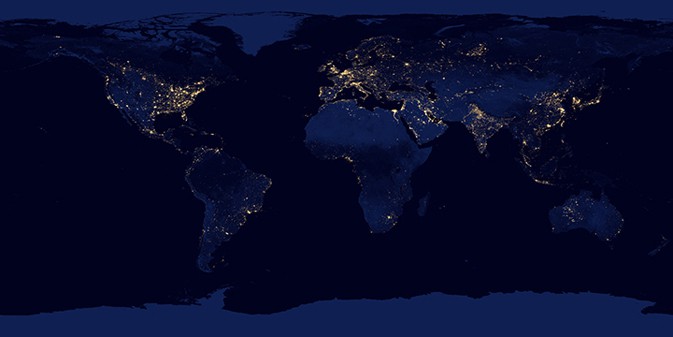

Credit: NASA Earth Observatory/NOAA NGDC
Scientists have unveiled an unprecedented new look at our planet at night. A global composite image, constructed using cloud-free night images from a new NASA and National Oceanic and Atmospheric Administration (NOAA) satellite, shows the glow of natural and human-built phenomena across the planet in greater detail than ever before.
Many satellites are equipped to look at Earth during the day, when they can observe our planet fully illuminated by the Sun. With a new sensor onboard the NASA-NOAA Suomi National Polar-orbiting Partnership (NPP) satellite launched last year, scientists now can observe Earth’s atmosphere and surface during nighttime hours.
The new sensor, the day-night band of the Visible Infrared Imaging Radiometer Suite (VIIRS), is sensitive enough to detect the nocturnal glow produced by Earth’s atmosphere and the light from a single ship in the sea. Satellites in the U.S. Defense Meteorological Satellite Program have been making observations with low-light sensors for 40 years. But the VIIRS day-night band can better detect and resolve Earth’s night lights, providing researchers with valuable data for a wide variety of previously unseen or poorly seen events.
“For all the reasons that we need to see Earth during the day, we also need to see Earth at night,” said Steve Miller, a researcher at NOAA’s Colorado State University Cooperative Institute for Research in the Atmosphere. “Unlike humans, the Earth never sleeps.”
The day-night band observed Hurricane Sandy, illuminated by moonlight, making landfall over New Jersey on the evening of Oct. 29. Night images showed the widespread power outages that left millions in darkness in the wake of the storm. With its night view, VIIRS is able to detect a more complete view of storms and other weather conditions, such as fog, that are difficult to discern with infrared, or thermal, sensors. Night is also when many types of clouds begin to form.
“The use of the day-night band by the National Weather Service is growing,” said Mitch Goldberg, program scientist for NOAA’s Joint Polar Satellite System. For example, the NOAA Weather Service’s forecast office in Monterey, Calif., is now using VIIRS day-night band images to improve monitoring and forecasting of fog and low clouds for high air traffic coastal airports like San Francisco. According to Goldberg, VIIRS images were used on Nov. 26, the Monday after Thanksgiving, to map the dense fog in the San Francisco Bay area that resulted in flight delays and cancellations.
Unlike a camera that captures a picture in one exposure, the day-night band produces an image by repeatedly scanning a scene and resolving it as millions of individual pixels. Then, the day-night band reviews the amount of light in each pixel. If it is very bright, a low-gain mode prevents the pixel from over-saturating. If the pixel is very dark, the signal is amplified.
“It’s like having three simultaneous low-light cameras operating at once and we pick the best of various cameras, depending on where we’re looking in the scene,” Miller said. The instrument can capture images on nights with or without moonlight, producing crisp views of Earth’s atmosphere, land and ocean surfaces.
“The night is nowhere as dark as we might think,” Miller added.


Be the first to comment